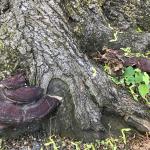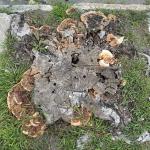Root and Butt Rot caused by Ganoderma sessile
Pathogen
The native fungal pathogen Ganoderma sessile (previously known as G. lucidum) is sometimes referred to as the reishi mushroom but generally has no common name. This species is one of the most common root and butt rot pathogens in the northeast (Luley 2022). A complex of Ganoderma species comprises the “laccate Ganoderma” group, some with overlapping host ranges (Loyd et al. 2018). Ganoderma curtisii is also a member and occurs in the northeast. Ganoderma applanatum (artist’s conk) is not a member of the laccate Ganoderma group.
Hosts
Oaks (Quercus spp.), maples (Acer spp.), beech (Fagus spp.) and honeylocust (Gleditsia tricanthos) are the primary hostsin southern New England, but the pathogen has a broad host range among deciduous hardwoods (Sinclair and Lyon 2005). However, some expanded host lists include several unique Ganoderma species that were previously known only as G. lucidum (Loyd et al. 2018).
Symptoms & Signs
Ganoderma sessile can be found attacking the roots and lower trunk of infected hardwoods. Yet in many cases, the decay is primarily concentrated in the roots and damage in the lower trunk is less severe (Luley 2022). Wounds on the lower trunk and root flare are a common source of infection for trees in suburban and urban settings (Sinclair and Lyon 2005). Annual conks are often produced near the wound that facilitated infection. The conks are soft and amorphous when young, becoming shelf-like and tough, but still pliable, as they mature. Conks occur singly or in overlapping groups, growing from lateral roots several feet away from the tree or directly from the root flare and base of the trunk. The upper surface of the conk (pileus) is reddish-brown and may have a bright white margin while the lower surface (hymenium) has a white pore layer. The upper surface is also waxy giving it a varnished appearance. In southern New England, conks can be found growing from late August through October, typically becoming mature in late September to early October. The conks may persist for more than one year but after freezing they appear dark maroon or mahogany in color. Dead conks will often persist for more than one year, allowing for pathogen identification when new conks have not yet formed.
The occurrence of conks does not necessarily indicate that extensive decay is present. The pathogen may produce fruiting bodies when only localized decay in the roots or lower trunk has occurred (Sinclair and Lyon 2005, Luley 2022). As a result, conks may develop before any significant decline develops in the canopy. When infections are advanced, general canopy dieback symptoms may be observed or no symptoms of the infection will be visible. However, dead bark and decaying sapwood will often be present near the site of the fruiting bodies on the lower trunk. Wood infected by G. sessile appears light-colored and stringy to spongy (Sinclair and Lyon 2005). Nearly all Ganoderma species selectively delignify wood tissues in both the heartwood and sapwood (Schwarze et al. 2000). This pattern of white rot can very slowly lead to reductions in structural stability. Therefore, infected trees may remain stable for many years before the wood tissue finally breaks down and cavities form.
Management
Because the presence of a single or even several conks does not indicate extensive decay is present, careful consideration must be made before removing infected trees. Minimally invasive decay detection techniques, such as resistance drilling and sonic tomography, can be used to better understand the location and severity of the decay. However, as noted previously, decay may be concentrated in the roots where drilling/tomography cannot be utilized. Regardless, trees with conks should receive a thorough risk assessment. Document the occurrence and number of conks produced each year. As with any tree infected by a root and butt rot pathogen, maintaining high tree vigor is important. If annual increment growth can keep pace with the rate of decay in the heartwood, this may reduce the risk of failure. Maintain a large ring of mulch or wood chips around the tree and manage insect pests and pathogens that can weaken the tree. Improving soil quality may also increase vigor. Pruning to reduce canopy sway can also be performed.
References
Loyd AL, Barnes CW, Held BW, Schink MJ, Smith ME, Smith JA, and Blanchette RA. 2018. Elucidating "lucidum": Distinguishing the diverse laccate Ganoderma species of the United States. PLoS One 13(7): e0199738.
Luley, CJ. 2022. Ganoderma sessile. In: Wood Decay Fungi Common to the Northeast &a Central United States, 2nd Edition. Urban Forest Diagnostics LLC, Naples, NY. Pp. 58–59.
Schwarze FWMR, Engels J, and Mattheck C. 2000. Fungal Strategies of Wood Decay in Trees. Springer, Berlin, Germany.
Sinclair WA and Lyon, HH. 2005. Diseases of Trees and Shrubs, 2nd edn. Cornell University Press, Ithaca, NY.






